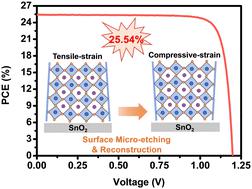当前位置:
X-MOL 学术
›
Energy Environ. Sci.
›
论文详情
Our official English website, www.x-mol.net, welcomes your
feedback! (Note: you will need to create a separate account there.)
Stress regulation via surface micro-etching and reconstruction for enhancing triple-cation perovskite solar cells with an efficiency of 25.54%
Energy & Environmental Science ( IF 32.4 ) Pub Date : 2024-10-22 , DOI: 10.1039/d4ee04248d Yang Ding, Erming Feng, Siyuan Lu, Jianhui Chang, Caoyu Long, Sichao Tong, Hengyue Li, Junliang Yang
Energy & Environmental Science ( IF 32.4 ) Pub Date : 2024-10-22 , DOI: 10.1039/d4ee04248d Yang Ding, Erming Feng, Siyuan Lu, Jianhui Chang, Caoyu Long, Sichao Tong, Hengyue Li, Junliang Yang

|
Residual stresses generated within perovskite films during the high-temperature annealing and cooling process are the key contributors to the reduction of device performance and lifespan deterioration. Herein, a strategy of surface micro-etching and reconstruction is developed to regulate the stresses in a triple-cation (formamidine, methylamine, and cesium) perovskite film. A precise stoichiometric mixture of L-lactic acid (LA) and isopropanol (IPA) is used to controllably dissolve the surface of the perovskite film, followed by octylammonium iodide (OAI) post-treatment, enabling a sinking reconstruction of 2D perovskite from the surface to bulk phase and achieving a benign transition from surface tensile stress to compressive stress, as well as a more matchable interface energy level. As a result, the target perovskite solar cells (PSCs) yield an obviously enhanced power conversion efficiency (PCE) of 25.54%, which is the highest reported PCE for triple-cation PSCs. Meanwhile, PSC modules with 10.4 cm2 achieve a PCE of 21.02%. Furthermore, the surface micro-etched and reconstructed PSCs exhibit superior stability, and the PSC devices without encapsulation can maintain 83% of original efficiency after 500 hour illumination at maximum power point tracking (MPPT) in a N2 atmosphere. This study provides a valuable avenue to improve PSC stability and efficiency by regulating residual stresses through surface micro-etching and reconstruction.
中文翻译:

通过表面微蚀刻和重构进行应力调节,以增强效率为 25.54% 的三阳离子钙钛矿太阳能电池
在高温退火和冷却过程中,钙钛矿薄膜内产生的残余应力是导致器件性能降低和寿命恶化的关键因素。在此,开发了一种表面微蚀刻和重构策略来调节三阳离子(甲脒、甲胺和铯)钙钛矿膜中的应力。使用 L-乳酸 (LA) 和异丙醇 (IPA) 的精确化学计量混合物可控地溶解钙钛矿薄膜的表面,然后进行辛基碘化铵 (OAI) 后处理,使 2D 钙钛矿从表面到体相的下沉重建成为可能,并实现从表面拉伸应力到压应力的良性转变,以及更匹配的界面能级。结果,目标钙钛矿太阳能电池 (PSC) 产生的功率转换效率 (PCE) 明显增强至 25.54%,这是三阳离子 PSC 中报道的最高 PCE。同时,10.4 cm2 的 PSC 模块实现了 21.02% 的 PCE。此外,表面微蚀刻和重构的 PSC 表现出优异的稳定性,在 N2 气氛中,未封装的 PSC 器件在最大功率点跟踪 (MPPT) 下照射 500 小时后仍能保持 83% 的原始效率。本研究通过表面微蚀刻和重建调节残余应力,为提高 PSC 稳定性和效率提供了有价值的途径。
更新日期:2024-10-22
中文翻译:

通过表面微蚀刻和重构进行应力调节,以增强效率为 25.54% 的三阳离子钙钛矿太阳能电池
在高温退火和冷却过程中,钙钛矿薄膜内产生的残余应力是导致器件性能降低和寿命恶化的关键因素。在此,开发了一种表面微蚀刻和重构策略来调节三阳离子(甲脒、甲胺和铯)钙钛矿膜中的应力。使用 L-乳酸 (LA) 和异丙醇 (IPA) 的精确化学计量混合物可控地溶解钙钛矿薄膜的表面,然后进行辛基碘化铵 (OAI) 后处理,使 2D 钙钛矿从表面到体相的下沉重建成为可能,并实现从表面拉伸应力到压应力的良性转变,以及更匹配的界面能级。结果,目标钙钛矿太阳能电池 (PSC) 产生的功率转换效率 (PCE) 明显增强至 25.54%,这是三阳离子 PSC 中报道的最高 PCE。同时,10.4 cm2 的 PSC 模块实现了 21.02% 的 PCE。此外,表面微蚀刻和重构的 PSC 表现出优异的稳定性,在 N2 气氛中,未封装的 PSC 器件在最大功率点跟踪 (MPPT) 下照射 500 小时后仍能保持 83% 的原始效率。本研究通过表面微蚀刻和重建调节残余应力,为提高 PSC 稳定性和效率提供了有价值的途径。


















































 京公网安备 11010802027423号
京公网安备 11010802027423号